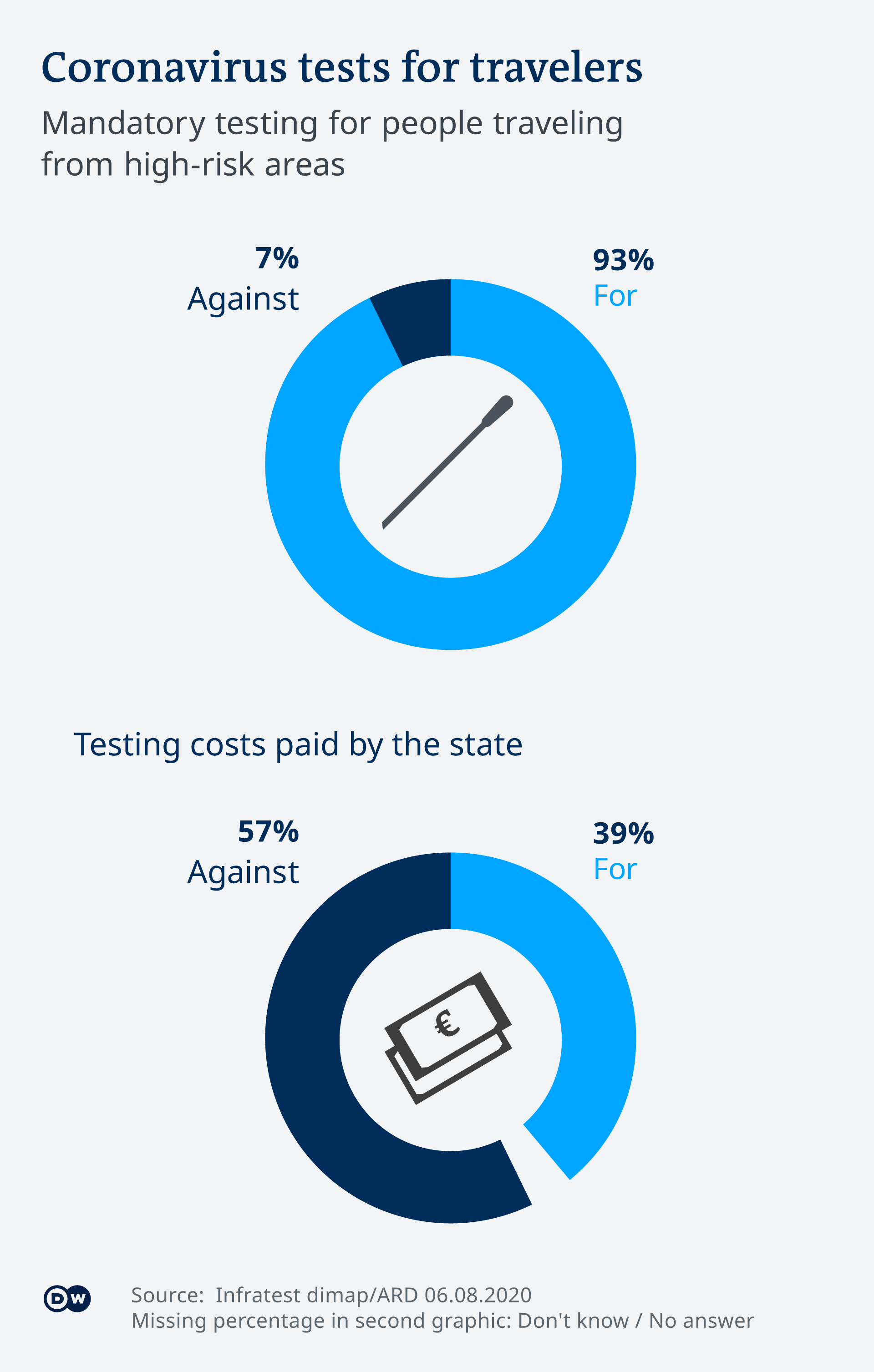“約莫台灣時間25日凌晨兩點
德國宣布放棄普篩,改用14天隔離
German Airports to Offer Free COVID-19 Tests to Returning ...
www.schengenvisainfo.com › news
2020/07/27 - Germany's Health Ministry has decided to offer free Coronavirus tests to returning travellers at all German airports, in an effort to prevent a surge of COVID-19 cases due to summer travel. According to Berlin's Health Minister, ...
Mandatory coronavirus testing at airports in Germany off to ...
www.dw.com › mandatory-coronavir...
2020/08/08 - A coronavirus test center has been in operation at Frankfurt airport since June 29. Here, passengers both departing and arriving can be tested to avoid quarantine. The standard procedure, in which the results are available as a download within six to eight hours, costs €59. Around 300 tests can be performed per hour.
Mandatory coronavirus testing at airports in Germany off to smooth start
Operators of airport testing centers across Germany reported minimal wait times and ample supplies. Meanwhile, EU members Romania and Bulgaria were added to Germany's list of high-risk countries.
Germany's coronavirus testing requirement for travelers flying in from high-risk countries came into force with few complications on Saturday.
Coronavirus testing booth operators at Germany's largest airport, Frankfurt Airport, said they did not see any major problems or notice a large increase in the number of people waiting to be tested.
"This is slightly more than in the past few days," Benedikt Hart, the head of the German Red Cross-operated testing center at the airport told the DPA news agency. "The people have understanding. There are no disgruntled passengers."
A Hamburg Airport spokesperson echoed that statement, saying that there were no complications related to the testing, and that passengers arriving from high-risk countries didn't face more than a 30-minute wait to be tested. In Berlin, tests carried out at both Tegel and Schönefeld airports, as well as the central bus station were carried out with relative simplicity and only sporadic queues.
The tests are typically to be taken directly upon arrival at airports, but are also available free of charge at separate testing centers and medical practices up to three days after arrival.
DW correspondent Konrad Busen, who was at Frankfurt Airport, said the introduction of testing was expected to increase the number of cases identified.
"Up until now here in Frankfurt the number of positive tests has been relatively small, around about 1% of the about 2,000 people tested here per day have been positive," he said. "This number is expected to rise now as compulsory testing is introduced for people traveling from high-risk countries."
Praise and condemnation
The largest German doctor's union, the Marburger Bund, welcomed the move, citing a higher rate of positive tests in people coming from high-risk countries. "The obligatory testing could make this even more obvious, because people with a tendency toward risky behavior are more likely to bypass voluntary testing stations," Marburger Bund Chairwoman Susanne Johne said.
However, other practitioners have criticized the broad requirement. The risk areas are "much too general" and many general practitioners do not have the capacity to handle a "rush of people" asking to be tested, Ulrich Weigeldt, the chairman of the German Association of General Practitioners, told Die Welt newspaper.
He also said it was "absurd" that returning travelers should have to give a doctor proof that they were abroad, adding that general practitioners are "not a branch of the Federal Ministry of Health."

As an alternative to being tested in Germany, people arriving from abroad can be tested in the country where they were vacationing within 48 hours of their flight. Health authorities are, however, encouraging travelers to be tested a second time five to seven days after their journey.
Around 130 countries, including the United States, Egypt and Russia are listed as high-risk by the Robert Koch Institute, Germany's health research agency. High-risk EU countries include Luxembourg, the Belgian province of Antwerp, several regions of Spain and parts of Romania and Bulgaria. A place is considered to be high risk once the number of new infections in the past week rises above 50 cases per 100,000 people.
The number of infections in Germany has been steadily on the rise over the past weeks, with experts warning of a second wave. The daily number of new infections rose by over 1,000 for the third day in a row on Saturday, reflecting a trend not seen since May. The country has recorded nearly 217,000 cases and a death toll of 9,201.
沈政男:德國過去一周檢測多少人次?87萬!這樣的數字要怎麼套用到台灣?台灣目前一天檢驗不到2百人次,台灣一周檢測1487。這事情的癥結就在於,全世界就只有台灣把PCR檢測弄成好像骨髓檢測那麼嚴重
德國入境普篩上路兩週「檢測實驗室已瀕崩潰」漢堡市長:嚴重錯誤
新頭殼newtalk | 楊清緣 綜合報導
發布 2020.08.24 | 04:29
武漢肺炎禍害全球,疫情持續在世界各地延燒,而入境普篩議題始終在我國爭論不休,國民黨擬聯合十四個執政縣市入境普篩。不過,德國近日試行入境普篩,僅兩周就造成病毒篩檢實驗室瀕臨崩潰;對此,德國漢堡市長曾薛爾(Peter Tschentscher)受訪指出,德國聯邦政府實施入境普篩是嚴重錯誤。
根據德媒《時代週報》報導,德國從8月起施行入境普篩,要求自風險地區前往德國的旅客,必須接受強制篩檢,在上路約兩週後,德國知名病毒學家克德羅斯滕(Christian Drosten)向柏林市長穆勒(Michael Müller)及衛生參議員卡萊奇(Dilek Kalayci),建議中止在德國機場的免費新冠病毒普篩,德羅斯滕也提到,由於「全世界必要的試劑和消耗品僅有一定額度」,目前產能正在耗盡,檢測實驗室已達到負荷極限。
德羅斯滕還簽署了一份機構內的文件,其中表明「柏林的實驗室在過去幾週內已經無法再對前往德國的旅客進行檢測,呼籲採取其他策略」;此外羅伯特·科赫研究所 (RKI) 也在21日時提出警告:「由於新冠病毒檢體數量眾多,會對檢測結果的評估造成問題,另外參與檢測的實驗室也通報了試劑的運送有問題」。
對於德國入鏡普篩的政策,漢堡市長曾薛爾接受《明鏡周刊》採訪時強調,德國衛生部長斯帕恩(Jens Spahn)犯下嚴重錯誤,許多入境普篩測試為陰性的人,在篩檢幾天後才轉為陽性,偽陰性者也會在入境普篩的政策下造成防疫破口。德國聯邦政府則表示,目前正在研究可能的解決方案,並將這個問題列入衛生部週一會議的議程中。
---
---
1. 中國上海再添一例從台灣移入病例,而且是有症狀。指揮中心是不是又要設法證明是偽陽性?如果你都認為台灣社會已經沒有病毒了,當然這些外國驗出的陽性病例就只能是偽陽性。李秉穎的論調是「若有病毒,一定會有重症!」問題是根本沒有任何實證根據,就只是幾個月來從各國經驗累積的粗略印象。
2. 上週上海那例,驗了五次病毒,只有中間那次陽性,這代表什麼?偽陽性?錯!這代表另外四次是偽陰性。PCR的問題是偽陰性,而不是偽陽性,指揮中心根本搞錯了。而且說,「根據NEJM,PCR的敏感性是90%」,其實人家根本沒這樣說。那篇文章講得很清楚,中國大陸與其他國家做過偽陰性研究,平均值約為2-29%。
3. 如果PCR的偽陰性是2%,那麼連續做兩次都是偽陰性的機會就小到可以忽略,而即使是10%,偽陰性也會變成1%,於是指揮中所說的,「普篩250,000人,會有50個偽陰性」,就會變成只有5個偽陰性。
4. 500個陽性,錯放5個,能不能接受?這是風險承受意願問題。同樣的,隔離十四天,只要無症狀就不檢測,那麼錯放的機會有多大?還有,注意了,居家檢疫並非機構檢疫,仍有傳染給家人的風險,比如四月就有三個家庭因此感染,而這些被感染的家人將病毒散播出去的風險是多少?上述兩者加總起來,會不會達到500個陽性、錯放5個的程度?如果會,是不是可用兩次檢測來取代居家檢疫十四天?這就是冰島目前所採行的入境篩檢模式,也就是可以隔離十四天,但也可以接受兩次檢測後放行,只須隔離三到五天。討論普篩與否,是不是要從這樣的科學角度?但整個台灣社會有能力嗎?連指揮中心都做不到。
5. 不要把人家當成盤子,就你最會算C/P值,其實你什麼都不懂,只會在那邊喊燒。比如以「漢堡市長呼籲德國取消入境普篩」的新聞來說,知否德國過去一周檢測多少人次?87萬!這樣的數字要怎麼套用到台灣?台灣目前一天檢驗不到2百人次。這事情的癥結就在於,全世界就只有台灣把PCR檢測弄成好像骨髓檢測那麼嚴重,但明明中國大陸可以篩篩篩五連篩,若無其事。
6. 有沒有看到指揮中心開始評估「外國人入境隔離後自費篩檢」?不是說不要入境普篩嗎?怎麼加了外國人與自費,就可以了?不是說隔離十四天+七天健康管理是大絕招嗎?怎麼外國人須另眼看待?顯然,隔離十四天還不夠,而且既然PCR檢測不是什麼困難事,當然要用來補強隔離措施。
7. 現在有人在抓台大公衛的小辮子,說什麼IRB、RIB、MIB有蹊蹺,拜託,這跟選舉到了就去查人家的論文,在路上開車沒事就跟蹤當檢舉達人,有何兩樣?這就是台灣,完全被病毒顯影。有沒有看到台大公衛一說延後公布研究結果,指揮中心馬上要求必須公布!不然要說明理由!拜託,傳染病防治法可以擴權到這個程度嗎?
沒有留言:
張貼留言